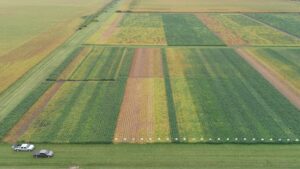Early planting comes with risk, and that risk must be mitigated. You can give growers an edge in protecting their seed investment.
Early planting of soybean is catching on. Your role is pivotal in helping growers make informed decisions that lead to a successful soybean harvest. Early soybean planting is a practice that has garnered considerable interest, but growers need to be equipped with the knowledge to achieve the best possible outcomes.

Seed Applied Technology Technical Sales Lead
While planting early can have benefits, I’ve seen too many growers end up facing challenges because of it, due to the fact they didn’t take full advantage of an important tool available to help safeguard the investment they’ve made in their seed.
Seed Treatment is Key in Making Early Planting Successful
Early planting is particularly attractive given how paramount maximizing productivity is to all growers. However, it’s important to recognize that early soybean planting comes with its own set of challenges.
The most significant risk is the unpredictable weather patterns that coincide with early planting. Cool and damp soil conditions can hinder germination, creating an environment conducive to the development of yield-robbing and stand-reducing seedling diseases.
This is where comprehensive seed treatments become essential.
To help your customers succeed in early soybean planting, it’s imperative to stress the importance of premium seed treatments with multiple modes of action. These treatments provide a holistic defense against the challenges presented by early planting, safeguarding your customers’ investment and instilling confidence as they navigate the challenges that can come with early planting of soybean.
Guarding Against Phytophthora
Phytophthora is a substantial threat, especially during the early planting season. It prefers warm saturated soils, especially where drainage is poor. This pathogen can lead to root rot, seedling blight and the damping off of otherwise healthy soybean plants. It is the number one yield-robbing, early-season disease in soybeans. You’ll find it everywhere soybeans are planted.
Fortunately, there are powerful tools at hand like Lumisena® fungicide seed treatment, an advanced seed treatment solution tailor-made to combat these threats. It’s like an insurance policy for soybean growers opting for early planting.
Lumisena, driven by its active ingredient oxathiapiprolin, has demonstrated its capability to enhance crop stands by over 2,500 plants per acre when facing severe Phytophthora pressure. It remains concentrated within the root system to shield young plants precisely at the infection site, in contrast to some other chemical solutions that tend to translocate rapidly throughout the entire plant.
As the sole seed-applied technology offering enduring protection throughout various stages of the Phytophthora pathogen’s life cycle, oxathiapiprolin exhibits efficacy as a preventive, curative, eradicative, and antisporulant fungicide, addressing multiple phases in the pathogen’s life cycle.
Understanding the Significance of Multiple Modes of Action to Protect Against Early-Season Diseases
Of course, multiple modes of action are important to tackle other diseases, like Pythium — the second most yield-robbing early season disease in soybean. One of the key factors that heightens the risk of Pythium during early soybean growth is the prevailing soil temperature. Cool and damp soil conditions, typical in early spring, create an ideal environment for this pathogen to thrive.
These conditions not only slow germination but also render young seedlings more susceptible to diseases like the above.
This is why the use of seed treatments with multiple modes of action — another one being ethaboxam— is crucial.
Multiple modes of action in seed treatments provide a comprehensive and layered protection against a range of potential threats. They deploy different mechanisms to tackle various disease-causing agents, ensuring that even if one mode encounters resistance from the pathogen or environmental factors, alternative strategies are in place to continue protecting the soybean seedling.
This multi-pronged protection is especially vital during early soybean planting, when the stakes are high, and the margin for error is slim.
Your role as a seed sales professional is to help educate your customers on the significance of premium seed treatments with highly effective modes of action, which serve as a robust line of defense against these early-season in-field challenges.
By understanding these dynamics and offering advanced solutions, you can empower your customers to navigate the complexities of early soybean planting successfully so they can maximize their yield potential.
Why are Growers Opting for Early Planting?
Some of the common reasons for early soybean planting include:
- Optimizing the Growing Season: Planting soybeans earlier can extend the growing season, which is especially beneficial in regions with short growing seasons or where frost can occur early in the fall.
- Higher Yields: Planting soybeans earlier may lead to higher yields, as the crop can take advantage of early-season sunlight and warmer temperatures. Early planting can result in better canopy development and more time for pods to form and fill.
- Reducing Risk of Heat Stress: Early planting can help avoid such heat stress during sensitive growth phases, especially flowering.
- Weed/Pest Management: Soybeans planted earlier may establish a stronger canopy, which can compete more effectively with weeds and potentially reduce the need for herbicides. Some pests may be less problematic with early planting.
- Crop Rotation and Double-Cropping: Early planting of soybeans can allow for the planting of a second crop, such as wheat or a cover crop, after the soybeans are harvested.
- Market Timing: Farmers may choose to plant soybeans earlier to have their crop ready for market at a specific time when prices are expected to be more favorable.
- Variety Selection: Some soybean varieties are bred to be early-maturing, and farmers may choose to plant these varieties to take advantage of early planting. Early maturing varieties can be more suitable for regions with shorter growing seasons.













